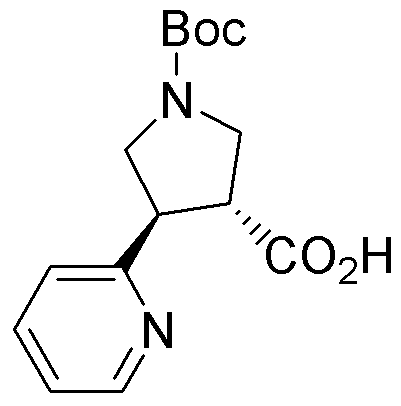Boc-(±)-trans-4-(2-pyridinyl)pyrrolidine-3-carboxylic acid is widely utilized in research focused on:
- Pharmaceutical Development: This compound serves as a key intermediate in the synthesis of various pharmaceuticals, particularly in the development of drugs targeting neurological disorders.
- Peptide Synthesis: It is commonly used in solid-phase peptide synthesis, allowing for the efficient construction of complex peptide sequences with enhanced stability and bioactivity.
- Research in Medicinal Chemistry: The compound is employed in the design of novel ligands for receptors, facilitating the discovery of new therapeutic agents with improved efficacy and selectivity.
- Biochemical Studies: It acts as a valuable tool in studying enzyme mechanisms and interactions, helping researchers understand biological processes at a molecular level.
- Material Science: This chemical is explored in the development of functional materials, such as polymers and coatings, that require specific chemical properties for enhanced performance.
Informations générales
Propriétés
Sécurité et réglementation
Applications
Boc-(±)-trans-4-(2-pyridinyl)pyrrolidine-3-carboxylic acid is widely utilized in research focused on:
- Pharmaceutical Development: This compound serves as a key intermediate in the synthesis of various pharmaceuticals, particularly in the development of drugs targeting neurological disorders.
- Peptide Synthesis: It is commonly used in solid-phase peptide synthesis, allowing for the efficient construction of complex peptide sequences with enhanced stability and bioactivity.
- Research in Medicinal Chemistry: The compound is employed in the design of novel ligands for receptors, facilitating the discovery of new therapeutic agents with improved efficacy and selectivity.
- Biochemical Studies: It acts as a valuable tool in studying enzyme mechanisms and interactions, helping researchers understand biological processes at a molecular level.
- Material Science: This chemical is explored in the development of functional materials, such as polymers and coatings, that require specific chemical properties for enhanced performance.
Documents
Fiches de données de sécurité (FDS)
La FDS fournit des informations de sécurité complètes sur la manipulation, le stockage et l’élimination du produit.
Spécifications du produit (PS)
Le PS fournit une description complète des propriétés du produit, notamment sa composition chimique, son état physique, sa pureté et les exigences de stockage. Il détaille également les plages de qualité acceptables et les applications prévues du produit.
Certificats d'analyse (COA)
Recherchez des certificats d'analyse (COA) en saisissant le numéro de lot du produit. Les numéros de lot et de lot se trouvent sur l'étiquette d'un produit, après les mots « Lot » ou « Lot de fabrication ».
Numéro de catalogue
Numéro de lot/série
Certificats d'origine (COO)
Ce certificat d'exploitation confirme le pays dans lequel le produit a été fabriqué, et détaille également les matériaux et composants utilisés et s'il est issu de sources naturelles, synthétiques ou autres sources spécifiques. Ce certificat peut être requis pour les douanes, le commerce et la conformité réglementaire.
Numéro de catalogue
Numéro de lot/série
Fiches de données de sécurité (FDS)
La FDS fournit des informations de sécurité complètes sur la manipulation, le stockage et l’élimination du produit.
DownloadSpécifications du produit (PS)
Le PS fournit une description complète des propriétés du produit, notamment sa composition chimique, son état physique, sa pureté et les exigences de stockage. Il détaille également les plages de qualité acceptables et les applications prévues du produit.
DownloadCertificats d'analyse (COA)
Recherchez des certificats d'analyse (COA) en saisissant le numéro de lot du produit. Les numéros de lot et de lot se trouvent sur l'étiquette d'un produit, après les mots « Lot » ou « Lot de fabrication ».
Numéro de catalogue
Numéro de lot/série
Certificats d'origine (COO)
Ce certificat d'exploitation confirme le pays dans lequel le produit a été fabriqué, et détaille également les matériaux et composants utilisés et s'il est issu de sources naturelles, synthétiques ou autres sources spécifiques. Ce certificat peut être requis pour les douanes, le commerce et la conformité réglementaire.


